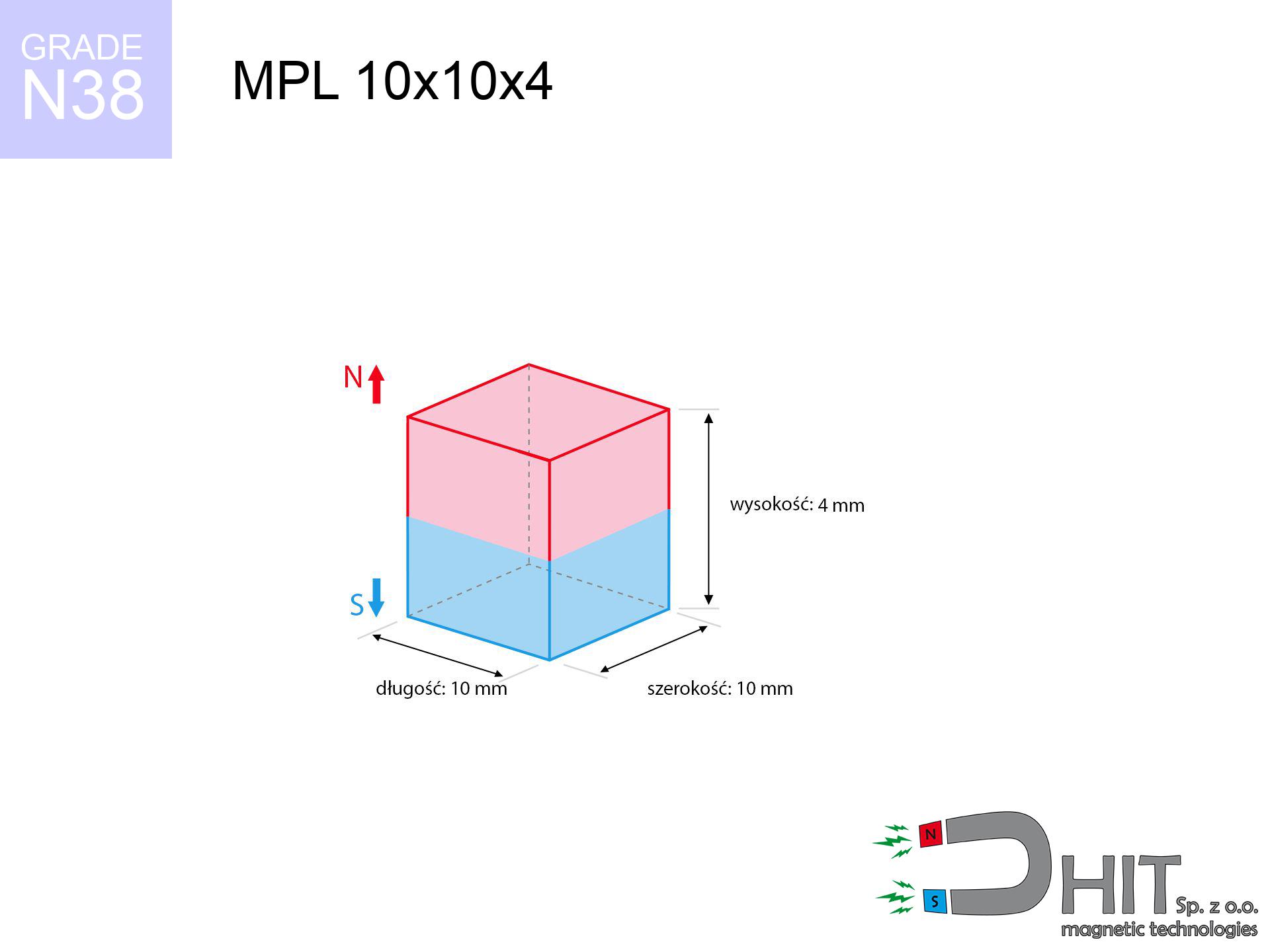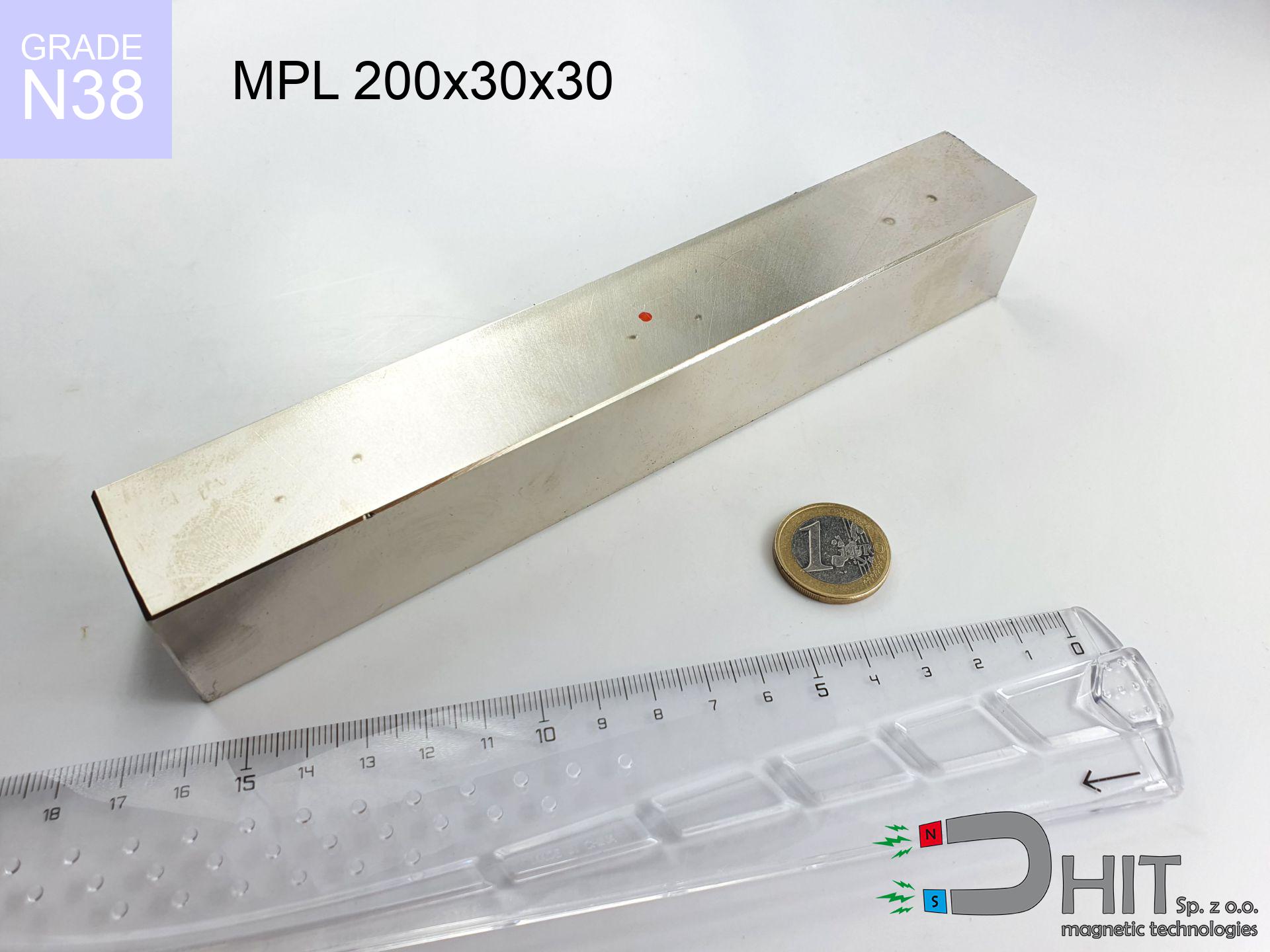MPL 10x10x4 / N38 - neodymium magnet
lamellar magnet
catalog number 020112
GTIN: 5906301811183
length
10
mm [±0,1 mm]
width
10
mm [±0,1 mm]
height
4
mm [±0,1 mm]
magnetizing direction
↑ axial
capacity ~
3.16 kg / 30.99 N
magnetic induction ~
360.85 mT / 3,608 Gs
max. temperature
≤ 80
°C
catalog number 020112
GTIN: 5906301811183
length
10 mm [±0,1 mm]
width
10 mm [±0,1 mm]
height
4 mm [±0,1 mm]
magnetizing direction
↑ axial
capacity ~
3.16 kg / 30.99 N
magnetic induction ~
360.85 mT / 3,608 Gs
max. temperature
≤ 80 °C
1.80 ZŁ gross price (including VAT) / pcs +
1.46 ZŁ net price + 23% VAT / pcs
bulk discounts:
need more quantity?Want to talk about magnets?
Give us a call tel: +48 22 499 98 98 or write through contact form on the contact page. You can check the mass as well as the appearance of neodymium magnet in our magnetic mass calculator magnetic calculator
Orders placed by 2:00 PM will be shipped on the same business day.
Specification: lamellar magnet 10x10x4 / N38 ↑ axial
Magnetic properties of the material N38
Physical properties of sintered neodymium magnets Nd2Fe14B
Contact Surface: Thanks to their flat shape, disc magnets provide a larger contact surface with adjoining parts, which is beneficial in applications requiring a stronger magnetic connection.
Applications in Technology: The magnets are often utilized in many devices, like sensors, stepper motors, or speakers, where a flat shape is crucial for their operation.
Mounting: This form's flat shape makes mounting, particularly when it's necessary to adhere the magnet to another surface.
Design Flexibility: The disc shape of the magnets gives designers with significant flexibility in placing them in constructions, which can be more difficult with magnets of other shapes.
Stability: In certain applications, the flat base of a disc magnet can provide better stability, minimizing the risk of shifting or rotating. It should be noted that the optimal shape of a magnet is dependent on the specific project and requirements. In certain cases, other shapes, such as cylindrical or spherical, may be more suitable.
Product suggestions
Advantages as well as disadvantages of neodymium magnets NdFeB.
Apart from immense strength, neodymium magnets have the following advantages:
- They do not lose their power (of the magnet). After approximately 10 years, their strength decreases by only ~1% (theoretically),
- They protect against demagnetization caused by external magnetic field extremely well,
- Thanks to the shiny finish and nickel, gold, or silver coating, they have an aesthetic appearance,
- They have exceptionally high magnetic induction on the surface of the magnet,
- Thanks to their high temperature resistance, they can operate (depending on the shape) even at temperatures up to 230°C and above...
- Thanks to the flexibility in shaping and the ability to adapt to specific requirements – neodymium magnets can be produced in many variants of shapes and sizes, which amplifies their universality in usage.
- Significant importance in the industry of new technologies – are utilized in hard drives, electric drive mechanisms, medical apparatus and other modern machines.
Disadvantages of neodymium magnets:
- They can break when subjected to a strong impact. If the magnets are exposed to impacts, we recommend using magnets in a metal holder. The steel housing in the form of a holder protects the magnet from impacts, and at the same time increases its overall strength,
- High temperatures can reduce the power of neodymium magnets. Typically, after heating above 80°C, most of them experience a permanent reduction in strength (although it is dependent on the shape and size). To prevent this, we offer special magnets marked with the symbol [AH], which are highly resistant to high temperatures. They can operate even at temperatures up to 230°C, making them an ideal solution for applications requiring high-temperature operation,
- Magnets exposed to a humid environment can corrode. Therefore, when using them outdoors, we recommend using waterproof magnets made of rubber, plastic, or other moisture-resistant materials,
- The use of a cover - a magnetic holder is recommended due to the limited production capabilities of creating threads or complex shapes in the magnet
- Possible danger to health from tiny fragments of magnets are risky, when accidentally ingested, which is crucial in the context of children's health. It's also worth noting that miniscule components of these products can hinder the diagnostic process when they are in the body.
Exercise Caution with Neodymium Magnets
Dust and powder from neodymium magnets are flammable.
Do not attempt to drill into neodymium magnets. Mechanical processing is also not recommended. Once crushed into fine powder or dust, this material becomes highly flammable.
Neodymium magnets are extremely fragile, resulting in their cracking.
In the event of a collision between two neodymium magnets, it can result in them getting chipped. They are coated with a shiny nickel plating similar to steel, but they are not as hard. In the case of a collision between two magnets, there can be a scattering of small sharp metal fragments in different directions. Protecting your eyes is essential.
Neodymium magnets can demagnetize at high temperatures.
While Neodymium magnets can lose their magnetic properties at high temperatures, it's important to note that the extent of this effect can vary based on factors such as the magnet's material, shape, and intended application.
If you have a nickel allergy, avoid contact with neodymium magnets.
Studies clearly indicate a small percentage of people who suffer from metal allergies such as nickel. An allergic reaction often manifests as skin redness and rash. If you have a nickel allergy, try wearing gloves or avoid direct contact with nickel-plated neodymium magnets.
Neodymium magnets are the most powerful, most remarkable magnets on the planet, and the surprising force between them can shock you at first.
To use magnets properly, it is best to familiarize yourself with our information beforehand. This will help you avoid significant harm to your body and the magnets themselves.
Under no circumstances should neodymium magnets be placed near a computer HDD, TV, and wallet.
Strong magnetic fields emitted by neodymium magnets can damage magnetic storage media such as floppy disks, credit cards, magnetic ID cards, cassette tapes, video tapes, or other devices. In addition, they can damage televisions, VCRs, computer monitors, and CRT displays. Avoid placing neodymium magnets in close proximity to electronic devices.
Neodymium magnets can attract to each other, pinch the skin, and cause significant injuries.
Magnets will jump and also clash together within a distance of several to almost 10 cm from each other.
People with pacemakers are advised to avoid neodymium magnets.
In the case of neodymium magnets, there is a strong magnetic field. As a result, it interferes with the operation of a heart pacemaker. Even if the magnetic field does not affect the device, it can damage its components or deactivate the entire device.
Keep neodymium magnets as far away as possible from GPS and smartphones.
Magnetic fields interfere with compasses and magnetometers used in navigation for air and sea transport, as well as internal compasses of smartphones and GPS devices.
Magnets should not be treated as toys. Therefore, it is not recommended for youngest children to have access to them.
Remember that neodymium magnets are not toys. Be cautious and make sure no child plays with them. In the case of swallowing multiple magnets simultaneously, they can attract to each other through the intestinal walls. In the worst case scenario, this can lead to death.
To illustrate why neodymium magnets are so dangerous, read the article - How very dangerous are very powerful neodymium magnets?.




![magnetic holder with hook 48x11x65 [M6] / N38 ↑ axial magnetic holder with hook 48x11x65 [M6] / N38 ↑ axial](https://cdn3.dhit.pl/graphics/products/umh-48x11x65-m6-wiw.jpg)



